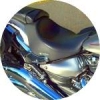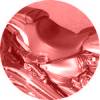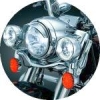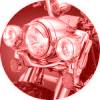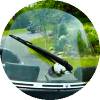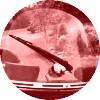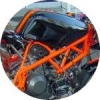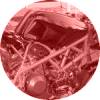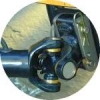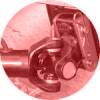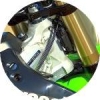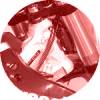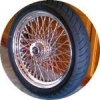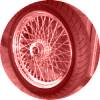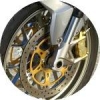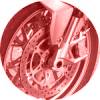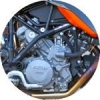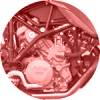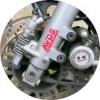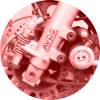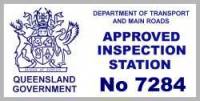Queensland Department of Transport and Main Roads introduced the safety certificate in November 1999 to replace the old roadworthy certificate or RWC, and it became
mandatory to obtain and display a current safety certificate on any registered motorcycle from the moment it's offered for sale.
The only times it's not required to display current safety certificate on a motorcycle for sale is when the motorcycle's either unregistered or is traded to or
between licensed motor dealers.
Queensland Department of Transport and Main Roads safety certificates can only be issued by Approved Inspection Stations (AIS), being service stations, garages or
workshops approved by Queensland Department of Transport and Main Roads to conduct inspections.
For private motorcycle sellers, Queensland Department of Transport and Main Roads safety certificates must be issued in the two months or 2000 kilometres prior to
sale, whichever comes first.
You are required to display a safety certificate in a conspicuous place and for motorcycles it's either on the forks or front guard.
Failure to display a Queensland Department of Transport and Main Roads safety certificate on the motorcycle from the time it's first offered for sale can carry an
on-the-spot fine penalty of $550.
Information on this website relating to motorcycle inspection is drawn from the Queensland Department of Transport and Main Roads Code of Practice for Approved
Inspection Stations (AIS) and Approved Persons; guidelines followed during safety certificate inspections and vehicle modification certification.
Following the code of practice guidelines below and rectifying faults you uncover should assure your motorcycle will pass on first inspection, avoiding any inconvenient
and possible costly re-inspection.
Vehicle inspection is subjective and the guidelines open to varying interpretation from inspector to inspector. Below is a list of reasons for possible rejection
pertaining to the Engine, Driveline and Emissions for the issuing of a Queensland Department of Transport and Main Roads safety certificate (formerly roadworthy
certificate or RWC).
SECTION 9 - ENGINE, DRIVELINE AND EMISSIONS
Objective: To ensure the engine, driveline and associated components provide a controlled transmission of power to the driving wheels.
In this section:-
Chain include a belt.
Drive line components includes constant velocity joints, universal joints, support bearings, splines or any other components that make up the drive
line.
Exhaust components include any part that makes up the exhaust system of a vehicle and includes the manifold, pipes, muffler, resonator and catalytic
converter.
Fuel delivery system includes carburettors, engine management and injection systems.
Powertrain means the engine and transmission.
Transmission includes gearbox.
9.1 CLUTCH OPERATION
Possible reasons for inspection rejection:
- Clutch components are not operational, are incorrectly adjusted or are cracked, bent or broken.
- There is leakage of hydraulic fluid from the system.
- There is an indication of air in the hydraulic system.
- When not in use, the clutch pedal does not return to its original position.
9.2 TRANSMISSION OPERATION (manual and automatic)
Possible reasons for inspection rejection:
- Any gear selected disengages whilst the vehicle is in motion.
- The gear lever location has been moved from the vehicle manufacturer's original position without specific approval.
- The gear selector linkage is worn so as to affect the safe use of the motor vehicle on a road.
- The transmission is worn so as to affect the safe use of the motor vehicle on a road (i.e. cannot select a gear/position easily or
selects the incorrect gear/position, excessive transmission/clutch slippage).
- The vehicle is able to be moved when park is selected (automatic transmission equipped vehicles).
- Where an automatic transmission is fitted, the engine is capable of being started in other than the park or neutral positions.
- A vehicle fitted with automatic transmission does not have, in the driver's compartment, an indicator showing the transmission control
position.
- Reverse gear is not fitted or cannot be selected (not applicable to L-group vehicle with an unladen mass of less than 450kg.
- The gear selector indicator (where applicable) is not operational or is not illuminated when the park/head lights are turned on.
9.3 ENGINE AND TRANSMISSION MOUNTINGS
Possible reasons for inspection rejection:
- The powertrain is not securely mounted to the chassis/frame of the vehicle.
- Powertrain mountings and bolts are not securely fastened or free of cracks or distortion.
- Rubber components are oil soaked, perished, broken or deteriorated.
9.4 LEAKS
Possible reasons for inspection rejection:
- Any component leaks oil on to the roadway or onto any exhaust system or brake component. (See Note 5)
- Seals and covers between the engine and passenger compartment are missing, distorted or damaged in a way that allows fumes to enter the
passenger compartment.
9.5 ENGINE
Possible reasons for inspection rejection:
- An emission related component originally fitted to the vehicle is altered, modified or removed so that it no longer operates as
intended.
9.6 REPLACEMENT ENGINE
Possible reasons for inspection rejection:
- A replacement engine, other than one offered as an option by the vehicle manufacturer for that make and model, is not certified by an
Approved Person or an endorsed departmental approval letter.
9.7 ENGINE CONTROLS
Possible reasons for inspection rejection:
- Engine controls as fitted by the manufacturer (including cruise control) do not operate in a smooth and efficient manner.
- Engine speed does not return to normal idle position upon release of the accelerator pedal or throttle control. (See Note 6)
- Vehicles fitted with a compression ignition engine (diesel) are not fitted with a locking device that prevents the engine from being
started by accidental and inadvertent means.
- Any component is adjusted so that it increases exhaust emissions including smoke.
9.8 DIFFERENTIAL
Possible reasons for inspection rejection:
- The differential is worn or modified so as to affect the safe use of the motor vehicle on a road.
- Drive line components are not secure or free of excessive wear, back lash or seizure which could cause component failure.
9.9 DRIVE SHAFTS, AXLES AND FLEXIBLE COUPLINGS
Possible reasons for inspection rejection:
- Constant velocity joint boots are not in good condition or are perished or deteriorated in such a way that lubricants can escape.
- Constant velocity joint boot retaining clamp/clips are missing, damaged or not performing their intended function.
- Any transmission drive shaft is bent, damaged, loose or noticeably misaligned.
- A chain is worn outside of manufacturer's specifications.
- Drive sprockets are not free from excessive wear or are incorrectly adjusted.
- A chain or drive shaft guard is not fitted, securely mounted, in good condition or it does not provide adequate cover. (See Note
7)
9.10 FUEL SYSTEM
Possible reasons for inspection rejection:
- Replacement fuel delivery systems do not continue to comply with the emission requirements applicable at the time of the vehicle's
manufacture.
- Air cleaners are not fitted. (See Note 8)
- An aftermarket turbocharger assembly other than one offered as an option by the vehicle manufacturer for that make and model is fitted
and is not certified by an Approved Person in accordance with the National Code of Practice for Light Vehicle Construction and Modification or an endorsed
departmental approval letter. (See Note 1)
- Nitrous oxide injection equipment is fitted, irrespective of its operational ability.
- The fuel filler pipe inlet and cap are not located on the outside of the vehicle unless originally fitted inside by the
manufacturer.
- Fuel system components are leaking.
- Fuel lines are in contact with moving parts, or a heat source, or are kinked, cracked or not secure.
- The fuel tank/s or fuel lines is/are affected by rust or corrosion.
- A fuel tank cap that complies with manufacturer's specifications is not fitted, is damaged or is not secure.
- Fuel hoses have incorrect fuel pressure ratings for their application or are not suitable for the fuel type.
- The fuel tank/s is/are not securely mounted or straps, supports, mounting brackets or fasteners are missing, cracked broken or
loose.
9.11 EXHAUST CONSTRUCTION
Possible reasons for inspection rejection:
- Any original emission related component is not properly located, connected, damaged, deteriorated or altered in any way to reduce
effectiveness (e.g. a catalytic converter is not fitted where one was originally provided or has been bypassed).
- Any pipe or muffler incorporated in the exhaust system to ensure the vehicle maintains compliance with ADRs for vehicle noise emission
is not fitted.
- Any alteration or modification to the exhaust system is not to a standard provided by the motor vehicle's original manufacturer or
Vehicle Standards Bulletin 14. (See Note 2)
- An exhaust system component fitted external to the motor vehicle body is not protected by suitable guarding.
- An exhaust system does not discharge in accordance with prescribed standards. (See Note 3)
- Exhaust components are not securely mounted with adequate clearance between other parts of the vehicle and the road.
- The exhaust system is fitted with a device designed to bypass noise and/or gaseous emission control devices which would render the
system non-complying to the ADRs.
- A motorbike manufactured from 1 July 1988 does not have all components of the silencing system marked with the name or trade name of
the manufacturer.
9.12 EMISSIONS
Possible reasons for inspection rejection:
- There are leaks or excessive noise from the exhaust system and joints during operation (excluding manufacturer's drain holes in
mufflers).
- The engine emits sparks, flames, excessive gases, oil or fuel residue.
- When operating, an engine of a motor vehicle manufactured after 1930 emits visible emissions for a period of 10 seconds or more. (See
Note 4)
- Any noise reducing or absorbing equipment is missing.
- Crankcase gases escape into the atmosphere (applies to petrol engines fitted with positive crankcase ventilation only).
9.13 DUAL FUEL SYSTEMS
Possible reasons for inspection rejection:
- A vehicle operating on Liquid Petroleum Gas (LPG) or Compressed Natural Gas (CNG) and petrol does not have the emission control
equipment fitted to enable compliance with emission levels when operating on petrol.
9.14 HYBRID ELECTRIC AND BATTERY ELECTRIC VEHICLES
CAUTION Hybrid/electric vehicles pose a risk of electric shock and should not be worked on unless the individual holds the correct certification
and has an understanding of the system.
It is important to remember that even with the vehicle's high voltage system disconnected a voltage/current can still be produced if the vehicle's wheels rotate.
Additionally, when inspecting a hybrid vehicle please be aware that unless the vehicle is completely shut down the combustion engine may start without warning to
charge the vehicle's battery.
Possible reasons for inspection rejection:
- High voltage cabling insulation is deteriorated, damaged or missing.
- High voltage cabling is not adequately secured.
- Battery pack is leaking.
- Battery pack is not secured.
- Battery ventilation system blocked or not operating.
- A motor, generator (including regenerative braking), combustion engine or combination of any units is damaged or does not operate as
intended which affects the safe operation of the vehicle (i.e. limited acceleration, failure to achieve normal road speeds, decreased braking performance).
Notes about Section 9 (Engine, driveline and emissions):
[1] Engines/turbochargers/superchargers fitted as optional equipment by the vehicle manufacturer are acceptable. This may require upgrading of vehicle
componentry to ensure it is identical to a vehicle originally produced by the manufacturer in this configuration.
[2] Proof of testing to an acceptable standard may be required.
[3] The exhaust outlet must:
a. extend at least 40mm beyond the furthermost outboard or rearmost joint of the floor pan which is not continuously welded or permanently sealed which could permit
direct access of exhaust gases to the passenger compartment, but not beyond the perimeter of the vehicle when viewed in plan;
b. if to the side of the vehicle, discharge to the right hand side of the vehicle and downwards at an angle to the horizontal of not less than 15 degrees and not more
than 45 degrees;
c. if to the rear of the vehicle, discharge at not more than 10 degrees above or 45 degrees below the horizontal.
[4] This does not apply to emissions that are visible only because of heat or the condensation of water vapour.
[5] Motorbikes manufactured with total loss lubricating systems which have been designed to "leak" are excluded from this condition.
[6] For Vintage and Veteran motorbikes manufactured without a self-releasing throttle, the throttle does not operate in the manner prescribed by the
manufacturer.
[7] The guard must provide protection for at least the upper free run of the drive chain and must extend at least 300mm rearward of the rearmost footrest or to
the vertical centre of the drive sprocket.
[8] If applicable, owner to supply documented confirmation that air cleaners were not fitted as original equipment.
























